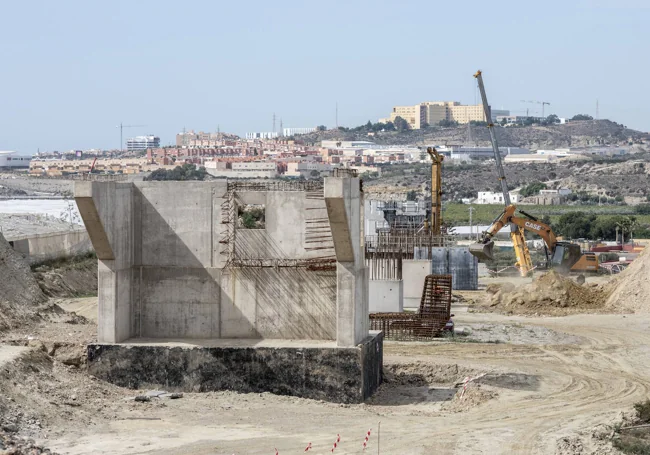The year 2026 has been the reference for the completion of the works on the Murcia-Almería high-speed line, as an extension of the Mediterranean Corridor, a calendar motivated by the deadlines set by the 'Next Generation' funds. Precisely the European mechanisms of the recovery and resilience fund guarantee the continuity of the works, which are safe from the effects derived from the extension of the General State Budgets. That said, the pace of execution of the works between Murcia and Almería makes it doubtful that the deadlines for the high speed to be operational in 2026 will be met.
Adif will have to work hard in less than three years to achieve this goal. Much of the infrastructure may be completed, but the construction of the new Lorca station will take a long time. Hence, several phases are proposed: firstly, resuming the rail service between Murcia and Lorca (at the San Diego station) with electric commuter trains, and subsequently the connection with Almería, and with Águilas through the new branch.
Deadlines for each option? It is not really known. The last reference that exists is the one given by the previous Minister of Transport, Raquel Sánchez, who told the businessmen of the Quiero Corredor Movement last year that they are working “at full capacity” so that the Mediterranean Corridor reaches Almería in 2026.
In addition to the above, the closest section for its implementation is the burying of the tracks in Barriomar and Nonduermas, linked to the new Carmen de Murcia station. It will probably be operational within the next year and rail traffic with Albacete through Cieza and Hellín can be resumed.
Progress of the works
Adif reports that it has given new impetus to the 200-kilometer Murcia-Almería High Speed Line, with the construction of one of its most relevant infrastructures: the Viator tunnel (878 meters), which runs under the industrial estate of La Juaida, the largest in the province, between Níjar and Almería.
Its execution represents a new technical and engineering challenge due to the characteristics of the terrain: the mine will be excavated from both mouths almost simultaneously. Likewise, a complex monitoring and soil reinforcement treatment system is deployed at certain points along the tunnel layout, which will run under buildings and streets in the polygon, he points out in a note.
The Railway Infrastructure Administrator indicates that the Murcia-Almería line is a “strategic axis of the Mediterranean Corridor”, with an investment of 3.5 billion euros. Currently, the 17 sections of the platform are underway (completed, under construction or contracted), while progress is being made in the deployment of tracks, equipment and systems that will be laid on it, he added.
Projects underway
Adif details that the projects are being drafted to address the assembly of the track along the entire route of the line, and that the contract for the construction of the assembly base for the first section d (Murcia-Lorca, 62 kilometers) is being finalized. at the same time that the project for the Lorca-Almería section (138 kilometers) is being drafted.
He points out that electrification is also underway: the assembly of the catenary and the rest of the equipment that supplies energy to the trains to circulate on the Murcia and Lorca section has already been contracted; and the construction of the Totana substation, while finalizing the contract for drafting the project for the two substations (Cuevas de Almanzora and Níjar) of the Lorca-Almería route.
He adds that progress is being made to contract the deployment of signaling and traffic management systems on the entire line and on the Pulpí-Águilas branch, which involves implementing ERTMS level 2, the most advanced train control and command system in the world.
Viaduct over the Andarax river, next to Almería.
ADIF

This is how the works are going in Almería territory
Viator Tunnel
ADIF
-U05338753777pLU-160x160@La%20Verdad.jpg)
Regarding the platform layout through Almería, the three sections under construction are more than 60% complete and in the access to Almería the excavation of screens has already begun, says Adif. This is how the sections are:
-Pulpí-Vera (25.7 km): the ten viaducts that it includes are under construction, in the Vera one the beams will begin to be placed this April.
-Vera-Los Arejos section (27.8 km): platform already completed.
-Los Arejos-Níjar section (17.8 km): six of the eleven viaducts are completed, the third launch phase is being prepared at Los Feos and progress is being made on the elevation of piers and abutments at Lucainena and Cebollero.
– Níjar-Río Andarax section (25.5 km), in addition to the construction of the Viator tunnel, the construction of the Río Andarax viaduct (1.4 km, the longest in the province) is advancing, by simultaneously promoting progress of the board with the conclusion of the last piles.
– Río Andarax-El Puche section (1.6 km): completed.- Integration in Almería Phase 1 (1.9 km): completed.
– Integration in Almería Phase 2 (1.9 km and new station): The excavation of the screens to channel the arrival of high speed underground is already underway. Also the work to enable the temporary bus station, which will allow boarding the new intermodal station.
#Murcia #connected #Almería #high #speed #truth